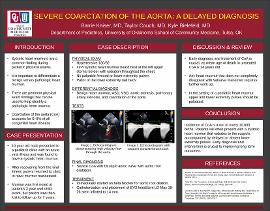Severe Coarctation of the Aorta: A Delayed Diagnosis
Abstract
INTRODUCTION: Coarctation of the aorta (CoA) is a congenital heart disease characterized by narrowing of the aorta near the aortic isthmus. The incidence of CoA is 4 out of every 10,000 births, accounting for 6–8% of all congenital heart disease. It is common for CoA to be accompanied by other cardiovascular abnormalities, such as bicuspid aortic valve, ventricular septal defects, and mitral valve stenosis. Early diagnosis and treatment of CoA is crucial to improving morbidity and mortality associated with this disease as the mean age of death in untreated coarctation is 34 years.
CASE DESCRIPTION: A 10 year old male presented to the outpatient pediatric clinic for an acute illness. On examination, he was found to be hypertensive with a blood pressure of 126/69 accompanied by a systolic heart murmur. Medical history included the diagnosis of a heart murmur at a 2 year well child examination before the patient was lost to follow-up until age 9. Upon re-establishment he was noted to have a II/VI systolic heart murmur. He was seen multiple times during year 10 of life where this murmur was consistently documented. Referral to cardiology for further evaluation was made. At presentation to the cardiologist, patient was found to be well appearing with clear lung sounds and a III/VI systolic murmur heard best at the left upper sternal boarder with radiation throughout the chest. During examination absent femoral and lower extremity pulses with pale lower extremity nail beds were also noted. Echocardiogram demonstrated severe CoA, bicuspid aortic valve, and aortic root dilatation. He was started on metoprolol for aortic root dilatation. Referral for heart catheterization was made for planned stenting to relieve the coarctation.
DISCUSSION: Heart murmurs are a common finding on pediatric exams. The primary care provider typically determines which heart murmurs are pathologic and require follow-up. In the setting of a heart murmur there are clinical signs that indicate when further follow-up with cardiology is needed, including absent distal pulses, hypertension, radiation of the murmur throughout the chest, and discrepancy between upper and lower extremity blood pressure. Early referral to cardiology is imperative for any murmur that is not innocent to prevent delayed diagnosis of pathologic lesions. This case demonstrates the importance of checking blood pressure and lower extremity pulses in the setting of an asymptomatic patient with a heart murmur.
Collections
The following license files are associated with this item:

